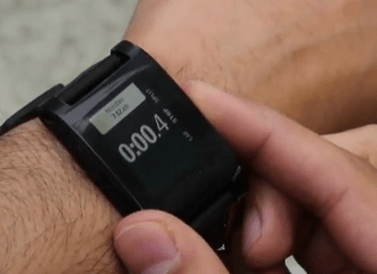The Pebble smart watch – a clever little device that connects to your iPhone or Android device and, oddly enough, tells the time – was a twinkle in the eye of founder Eric Migicovsky just a few weeks ago. Now the product has reached $2 million in funding. And if that weren’t enough, InPulse, the company that makes the Pebble, only ever asked for $100,000 over the course of the entire project.
It’s not only a testament to the watch itself, which from what I’ve seen is pretty damn cool, but a testament to the power of Kickstarter and crowd-funding in general.
We decided to have a little chat with Mr. Migicovsky to figure out how this incredible success story came to be. Here’s what we learned:
TechCrunch: Tell us about the team. Who are you guys and how did you come together on this?
Eric Migicovsky: The core of the team is from the University of Waterloo. I studied system design engineering there.
The Pebble is one of those classic four-year/overnight success stories. We had been working on smart watches for four years, but things have taken off in the last couple days. I had the idea about four years ago, while I was studying industrial design in Europe. I’m a big cyclist and wanted to be able to see what was happening on my phone without having to take it out on my bike. I wanted access to emails, texts, and calls without potentially dropping an expensive phone.
So… I built a prototype, got some friends aboard the team, and then after we graduated, we just kept working on it. In 2011 we launched InPulse, our first watch, and we got accepted into Y-Combinator. We moved from Waterloo to The Valley at the end of 2011.
Pebble is basically the evolution of InPulse. We have a ton of amazing customers and users that have been giving us feedback on what it’s like to use the watch, and so we’ve taken what we’ve learned — people want to run apps on their watch, be able to customize the digital watch face, etc. — and went back to the drawing board. That led to a watch that supports iPhone and Android with an e-paper screen. This means it looks great in sunlight and has excellent battery life (7 days).
TC: What led you to the idea of a watch in the first place?
EM: I like the idea that a watch is something that people wear on their body. It’s a personal object that they wear all the time. My thinking is: if you can succeed in making something people will wear every single day, you know you’re doing something right.
TC: What do you think caused people to fund you so quickly? Were you surprised?
EM: We were pretty surprised, yes. We had set our mark for $100,000 over the entire length of the project. An Engadget article spurred the first bit, but when we woke up on Wednesday morning and saw that we had hit our funding mark within two hours that was pretty amazing.
TC: There have been a lot of smart watches and many have failed. Why make this one? Why now?
EM: There are definitely a couple of competitors in the market. I think that everyone is iterating, and we’re simply iterating faster than anyone else. We have a smaller team, which gives us the ability to respond to customers needs faster and create software that people want.
There are only six people on the team right now, so we’re pretty tiny. And we’re closer to our customers. We respond to emails within hours — I’ve personally responded to thousands — and we even go to grab beers with our customers to see how they use the product in their everyday lives.
TC: What’s next for Pebble?
EM: We kind of have our work cut out for us right now.
We’ve got a pretty good manufacturing plan in place. We didn’t predict this in any way, but we have a plan in place for a large manufacturing run. We’ve already ordered components, and they’ll be ready for when we go into production.
TC: What advice would you give to people using Kickstarter to get funded?
EM: It’s like any other marketing effort. It’s not easy; you have to put a lot of effort into it. We spent weeks working on just the Kickstarter page, months maybe. We wanted to make sure that we conveyed our value proposition very well, so we focused on the customization angle.
In order to jumpstart a project like this, we weren’t just looking to sell it. We were looking to build a community. We made sure we had a hacker special on the page to get people thinking about apps we could write for the watch.
One thing we wanted to focus on with Kickstarter was our actual product, the Pebble. Other projects have extraneous stuff like t-shirts and buttons. We think that’s cool, and have even backed projects like that, but we wanted to focus on delivering an amazing watch.
We focused on Pebble.
